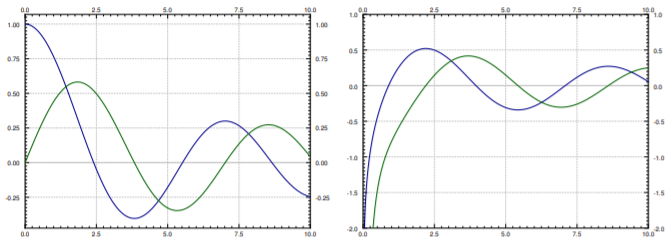9.3: Singular Points and the Method of Frobenius
( \newcommand{\kernel}{\mathrm{null}\,}\)
Examples
While behavior of ODEs at singular points is more complicated, certain singular points are not especially difficult to solve. Let us look at some examples before giving a general method. We may be lucky and obtain a power series solution using the method of the previous section, but in general we may have to try other things.
Let us first look at a simple first order equation
2xy′−y=0.
Note that x=0 is a singular point. If we only try to plug in
y=∞∑k=0akxk,
we obtain
0=2xy′−y=2x(∞∑k=1kakxk−1)−(∞∑k=0akxk)=a0+∞∑k=1(2kak−ak)xk.
First, a0=0. Next, the only way to solve 0=2kak−ak=(2k−1)ak for k=1,2,3,… is for ak=0 for all k. Therefore we only get the trivial solution y=0. We need a nonzero solution to get the general solution.
Let us try y=xr for some real number r. Consequently our solution---if we can find one---may only make sense for positive x. Then y′=rxr−1. So
0=2xy′−y=2xrxr−1−xr=(2r−1)xr.
Therefore r=12, or in other words y=x1/2. Multiplying by a constant, the general solution for positive x is
y=Cx1/2.
If C≠0 then the derivative of the solution "blows up" at x=0 (the singular point). There is only one solution that is differentiable at x=0 and that's the trivial solution y=0.
Not every problem with a singular point has a solution of the form y=xr, of course. But perhaps we can combine the methods. What we will do is to try a solution of the form
y=xrf(x)
where f(x) is an analytic function.
Suppose that we have the equation
4x2y″−4x2y′+(1−2x)y=0,
and again note that x=0 is a singular point. Let us try
y=xr∞∑k=0akxk=∞∑k=0akxk+r,
where r is a real number, not necessarily an integer. Again if such a solution exists, it may only exist for positive x. First let us find the derivatives
y′=∞∑k=0(k+r)akxk+r−1,y″=∞∑k=0(k+r)(k+r−1)akxk+r−2.
Plugging Equations ??? - 9.3.10 into our original differential equation (Equation ???) we obtain
0=4x2y″−4x2y′+(1−2x)y=4x2(∞∑k=0(k+r)(k+r−1)akxk+r−2)−4x2(∞∑k=0(k+r)akxk+r−1)+(1−2x)(∞∑k=0akxk+r)=(∞∑k=04(k+r)(k+r−1)akxk+r)−(∞∑k=04(k+r)akxk+r+1)+(∞∑k=0akxk+r)−(∞∑k=02akxk+r+1)=(∞∑k=04(k+r)(k+r−1)akxk+r)−(∞∑k=14(k+r−1)ak−1xk+r)+(∞∑k=0akxk+r)−(∞∑k=12ak−1xk+r)=4r(r−1)a0xr+a0xr+∞∑k=1(4(k+r)(k+r−1)ak−4(k+r−1)ak−1+ak−2ak−1)xk+r=(4r(r−1)+1)a0xr+∞∑k=1((4(k+r)(k+r−1)+1)ak−(4(k+r−1)+2)ak−1)xk+r.
To have a solution we must first have (4r(r−1)+1)a0=0. Supposing that a0≠0 we obtain
4r(r−1)+1=0.
This equation is called the indicial equation. This particular indicial equation has a double root at r=12.
OK, so we know what r has to be. That knowledge we obtained simply by looking at the coefficient of xr. All other coefficients of xk+r also have to be zero so
(4(k+r)(k+r−1)+1)ak−(4(k+r−1)+2)ak−1=0.
If we plug in r=12 and solve for ak we get
ak=4(k+12−1)+24(k+12)(k+12−1)+1ak−1=1kak−1.
Let us set a0=1. Then
a1=11a0=1,a2=12a1=12,a3=13a2=13⋅2,a4=14a3=14⋅3⋅2,…
Extrapolating, we notice that
ak=1k(k−1)(k−2)⋯3⋅2=1k!.
In other words,
y=∞∑k=0akxk+r=∞∑k=01k!xk+1/2=x1/2∞∑k=01k!xk=x1/2ex.
That was lucky! In general, we will not be able to write the series in terms of elementary functions. We have one solution, let us call it y1=x1/2ex. But what about a second solution? If we want a general solution, we need two linearly independent solutions. Picking a0 to be a different constant only gets us a constant multiple of y1, and we do not have any other r to try; we only have one solution to the indicial equation. Well, there are powers of x floating around and we are taking derivatives, perhaps the logarithm (the antiderivative of x−1) is around as well. It turns out we want to try for another solution of the form
y2=∞∑k=0bkxk+r+(lnx)y1,
which in our case is
y2=∞∑k=0bkxk+1/2+(lnx)x1/2ex.
We now differentiate this equation, substitute into the differential equation and solve for bk. A long computation ensues and we obtain some recursion relation for bk. The reader can (and should) try this to obtain for example the first three terms
b1=b0−1,b2=2b1−14,b3=6b2−118,…
We then fix b0 and obtain a solution y2. Then we write the general solution as y=Ay1+By2.
Method of Frobenius
Before giving the general method, let us clarify when the method applies. Let
p(x)y″+q(x)y′+r(x)y=0
be an ODE. As before, if p(x0)=0, then x0 is a singular point. If, furthermore, the limits
limx→x0 (x−x0)q(x)p(x)andlimx→x0 (x−x0)2r(x)p(x)
both exist and are finite, then we say that x0 is a regular singular point.
Often, and for the rest of this section, x0=0. Consider
x2y″+x(1+x)y′+(π+x2)y=0.
Write
limx→0 xq(x)p(x)=limx→0 xx(1+x)x2=limx→0 (1+x)=1,limx→0 x2r(x)p(x)=limx→0 x2(π+x2)x2=limx→0 (π+x2)=π.
So x=0 is a regular singular point.
On the other hand if we make the slight change
x2y″+(1+x)y′+(π+x2)y=0,
then
limx→0 xq(x)p(x)=limx→0 x(1+x)x2=limx→0 1+xx=DNE.
Here DNE stands for does not exist. The point 0 is a singular point, but not a regular singular point.
Below is part 1 of a video on the method of Frobenius.
Below is part 2 of a video on the method of Frobenius.
Let us now discuss the general Method of Frobenius1. Let us only consider the method at the point x=0 for simplicity. The main idea is the following theorem.
Method of Frobenius
Suppose that
p(x)y″+q(x)y′+r(x)y=0
has a regular singular point at x=0, then there exists at least one solution of the form
y=xr∞∑k=0akxk.
A solution of this form is called a Frobenius-type solution.
The method usually breaks down like this.
- We seek a Frobenius-type solution of the form y=∞∑k=0akxk+r. We plug this y into equation (???). We collect terms and write everything as a single series.
- The obtained series must be zero. Setting the first coefficient (usually the coefficient of xr) in the series to zero we obtain the indicial equation, which is a quadratic polynomial in r.
- If the indicial equation has two real roots r1 and r2 such that r1−r2 is not an integer, then we have two linearly independent Frobenius-type solutions. Using the first root, we plug in y1=xr1∞∑k=0akxk, and we solve for all ak to obtain the first solution. Then using the second root, we plug in y2=xr2∞∑k=0bkxk, and solve for all bk to obtain the second solution.
- If the indicial equation has a doubled root r, then there we find one solution y1=xr∞∑k=0akxk, and then we obtain a new solution by plugging y2=xr∞∑k=0bkxk+(lnx)y1, into Equation (???) and solving for the constants bk.
- If the indicial equation has two real roots such that r1−r2 is an integer, then one solution is y1=xr1∞∑k=0akxk, and the second linearly independent solution is of the form y2=xr2∞∑k=0bkxk+C(lnx)y1, where we plug y2 into (???) and solve for the constants bk and C.
- Finally, if the indicial equation has complex roots, then solving for ak in the solution y=xr1∞∑k=0akxk results in a complex-valued function---all the ak are complex numbers. We obtain our two linearly independent solutions2 by taking the real and imaginary parts of y.
The main idea is to find at least one Frobenius-type solution. If we are lucky and find two, we are done. If we only get one, we either use the ideas above or even a different method such as reduction of order (Exercise 2.1.8) to obtain a second solution.
Below is a video on using the method of Frobenious to solve a differential equation.
Below is another video on using the method of Frobenious to solve a differential equation.
Bessel Functions
An important class of functions that arises commonly in physics are the Bessel functions3. For example, these functions appear when solving the wave equation in two and three dimensions. First we have Bessel's equation of order p:
x2y″+xy′+(x2−p2)y=0.
We allow p to be any number, not just an integer, although integers and multiples of 12 are most important in applications. When we plug
y=∞∑k=0akxk+r
into Bessel's equation of order p we obtain the indicial equation
r(r−1)+r−p2=(r−p)(r+p)=0.
Therefore we obtain two roots r1=p and r2=−p. If p is not an integer following the method of Frobenius and setting a0=1, we obtain linearly independent solutions of the form
y1=xp∞∑k=0(−1)kx2k22kk!(k+p)(k−1+p)⋯(2+p)(1+p),y2=x−p∞∑k=0(−1)kx2k22kk!(k−p)(k−1−p)⋯(2−p)(1−p).
- Verify that the indicial equation of Bessel's equation of order p is (r−p)(r+p)=0.
- Suppose that p is not an integer. Carry out the computation to obtain the solutions y1 and y2 above.
Bessel functions will be convenient constant multiples of y1 and y2. First we must define the gamma function
Γ(x)=∫∞0tx−1e−tdt.
Notice that Γ(1)=1. The gamma function also has a wonderful property
Γ(x+1)=xΓ(x).
From this property, one can show that Γ(n)=(n−1)! when n is an integer, so the gamma function is a continuous version of the factorial. We compute:
Γ(k+p+1)=(k+p)(k−1+p)⋯(2+p)(1+p)Γ(1+p),Γ(k−p+1)=(k−p)(k−1−p)⋯(2−p)(1−p)Γ(1−p).
Verify the above identities using Γ(x+1)=xΓ(x).
We define the Bessel functions of the first kind of order p and −p as
Jp(x)=12pΓ(1+p)y1=∞∑k=0(−1)kk!Γ(k+p+1)(x2)2k+p,J−p(x)=12−pΓ(1−p)y2=∞∑k=0(−1)kk!Γ(k−p+1)(x2)2k−p.
As these are constant multiples of the solutions we found above, these are both solutions to Bessel's equation of order p. The constants are picked for convenience.
When p is not an integer, Jp and J−p are linearly independent. When n is an integer we obtain
Jn(x)=∞∑k=0(−1)kk!(k+n)!(x2)2k+n.
In this case it turns out that
Jn(x)=(−1)nJ−n(x),
and so we do not obtain a second linearly independent solution. The other solution is the so-called Bessel function of second kind. These make sense only for integer orders n and are defined as limits of linear combinations of Jp(x) and J−p(x) as p approaches n in the following way:
Yn(x)=limp→ncos(pπ)Jp(x)−J−p(x)sin(pπ).
As each linear combination of Jp(x) and J−p(x) is a solution to Bessel's equation of order p, then as we take the limit as p goes to n, Yn(x) is a solution to Bessel's equation of order n. It also turns out that Yn(x) and Jn(x) are linearly independent. Therefore when n is an integer, we have the general solution to Bessel's equation of order n
y=AJn(x)+BYn(x),
for arbitrary constants A and B. Note that Yn(x) goes to negative infinity at x=0. Many mathematical software packages have these functions Jn(x) and Yn(x) defined, so they can be used just like say sin(x) and cos(x). In fact, they have some similar properties. For example, −J1(x) is a derivative of J0(x), and in general the derivative of Jn(x) can be written as a linear combination of Jn−1(x) and Jn+1(x). Furthermore, these functions oscillate, although they are not periodic. See Figure 9.3.1 for graphs of Bessel functions.

Other equations can sometimes be solved in terms of the Bessel functions. For example, given a positive constant λ,
xy″+y′+λ2xy=0,
can be changed to x2y″+xy′+λ2x2y=0. Then changing variables t=λx we obtain via chain rule the equation in y and t:
t2y″+ty′+t2y=0,
which can be recognized as Bessel's equation of order 0. Therefore the general solution is y(t)=AJ0(t)+BY0(t), or in terms of x:
y=AJ0(λx)+BY0(λx).
This equation comes up for example when finding fundamental modes of vibration of a circular drum, but we digress.
Footnotes
[1] Named after the German mathematician Ferdinand Georg Frobenius (1849 – 1917).
[2] See Joseph L. Neuringera, The Frobenius method for complex roots of the indicial equation, International Journal of Mathematical Education in Science and Technology, Volume 9, Issue 1, 1978, 71–77.
[3] Named after the German astronomer and mathematician Friedrich Wilhelm Bessel (1784 – 1846).






